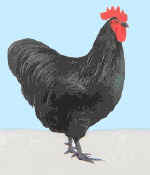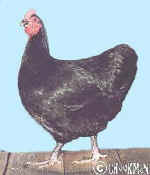The Australorp is by far the best known
Australian chicken.
They
were developed using primarily original William Cook type Orpingtons and Australian
Langshans. Then known as the Australian Orpington, this became the Austral Orpington and
finally, the Australorp. There was much dissent between the various states of Australia as
to a standard and it was not until 1949 that an Australian Standard was finally agreed to,
at a meeting of state delegates, called by Edwin Hadlington (the NSW Government Poultry
Expert). This Standard was adopted almost word perfectly by the British Poultry Club in
its Book of British Poultry Standards. The illustrations for this first Australian
Standard were of a cockerel bred by Jim O'Malley of Queanbeyan and a hen owned by the late
Claude Ubrihien of Bega.
The
Australorp is one of the World's finest utility breeds and proved itself in laying trials
for many years. In 1963 it was honoured at the World Poultry Congress being depicted on
medals and stamps. The breed was recognised as the single most important utility breed
ever developed.
The
Australorp could best be described as a bird of curves. There should be nothing angular
about these chickens at all. The back should be long and concave, sweeping gracefully up
to the tail. A most striking feature of the Australorp is its big, bold, black eye, which
sits in the centre of a clear, open, bright red face. The face has no signs of coarseness
and any hint of "beetle brows" should be eliminated. The plumage should be
glossy black with a rich beetle-green sheen and tight, not loose and fluffy as with
Orpingtons.
It
is a wonderful show bird, often winning major awards. It is quiet and docile and may be
had in both large and bantams. In Australia, only blacks are bred, this being the only
true colour. |

The ideal male -
Jim O'Malley's cockerel

The ideal female -
Claude Ubrihien's hen

A good type female bred near Queanbeyan, NSW
|